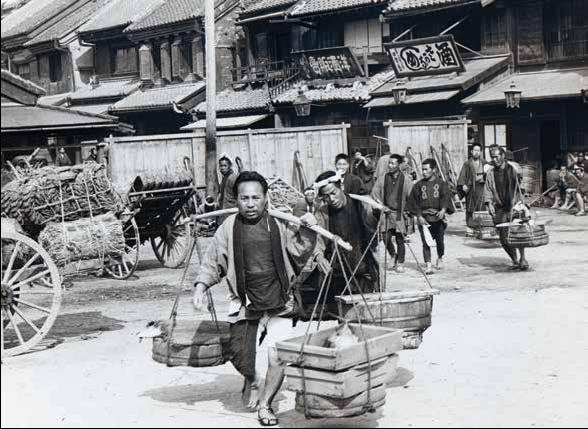The Tokyo Fish Market
If you ask anybody in Tokyo about the city’s Nihonbashi district, they’ll most probably call it a staid business area. The Bank of Japan and the Tokyo Stock Exchange are located there, so too the headquarters of many financial companies. Even the Mitsukoshi and Takashimaya department stores there are thought conservative.
This hasn’t always been the case. Until 1923, Nihonbashi housed a colorful and busy fish market right next to the famous Nihonbashi bridge, the point from which even today all distances to the capital are measured. For hundreds of years at the empire’s navel, the smell of fish and the shouts of fishermen, brokers and peddlers penetrated the air. Some 300 fish wholesalers were located at the market. From fishing villages as far away as Hokkaido, fish arrived early in the morning every day of the year. “Piscine types almost as varied and as beautiful as those at the marvelous Naples Aquarium may be seen,” gushed Terry’s Guide to the Japanese Empire in its 1920 edition.
Some of the fish, dried and salted, was distributed as far as Manchuria in northeastern China and the distant interior of China. But most of the supplies fed the inhabitants of Tokyo, or Edo as it was called until 1868. A good deal of it was fresh. That was no mean accomplishment at a time when transportation was by foot, horseback or boat. Horse-drawn carriages were unknown, and even oxcarts were rare. Japanese roads wouldn’t be ready for wheeled transport until well into the 20th century.
Keeping the fish fresh was a challenge. Some routes required constant transferring from boats to horses and back. Sailors transporting fish eventually learned to preserve premium merchandise by equipping their boats with saltwater tanks. Vendors used tubs or barrels. This custom survives to this day, with trucks outfitted with water tanks and shops with glass aquariums.
By 1721, Edo was the largest city in the world, with an estimated population of one million. Lots of mouths to feed. Some areas sent as many as 120 to 130 horses loaded with fish to the city every single day. These fish transports were important. Even the 1 — Boats are docked at the Nihonbashi fish market, ca 1890s. 2 — A streetcar crosses the Nihonbashi bridge, the white buildings on the right constitute the fishmarket, ca 1910s. 1 2 3 The Tokyo Fish Market processions of regional lords, which usually required everyone to stop and bow for them, would let fish transporters go ahead.
Men carrying large baskets unloaded the fish from boats docked at the back of the fish market. Vendors carried part of this to shops all over town, while buyers for restaurants and the many huge estates of regional lords purchased large amounts for themselves. Then there were the salesmen who peddled fish in tubs suspended on a long shoulder balanced pole, called a tenbinbo. They announced themselves in a loud sing-song voice. A housewife was able recognize the voice of her favorite salesman and be out before he reached her door.
It all sounds romantic, but it was a tough life. Fish prices were decided behind closed doors by a few powerful people in the market. This was done in the afternoon after the market closed, so vendors and brokers wouldn’t know what prices they’d have to pay until they’d sold their wares. Prices were far from fair. Vendors and brokers had to know their business to keep their heads above water.
As Japan started modernizing in the second half of the 19th century, free-market competition would replace this system and the fish market at Nihonbashi slowly began to loose its importance. Then the Great Kanto Earthquake of 1923 completely destroyed the barely surviving 300-yearold market. It was moved to Tsukiji, near Ginza. A modern market was completed there in 1935 and is still used today. This actually saved the market, as it was now organized on modern and transparent trading principles.
The bustling Tsukiji Market, officially called the Tokyo Metropolitan Central Wholesale Market, is the largest wholesale fish and seafood market in the world. Although best known for its seafood, the market also sells vegetables, fruit, beef and poultry. It handles more than 400 different types of seafood and employs more than 60,000 people. Together with two other Tokyo wholesale markets, Tsukiji handles an incredible 675,000 tons of marine products a year.
But the Tsukiji Market is soon coming to an end as well. In 2015, the market will move to new facilities on reclaimed land in Tokyo Bay. tj
 |
The complete article is available in Issue #271. Click here to order from Amazon


